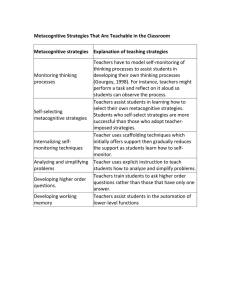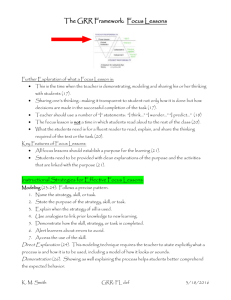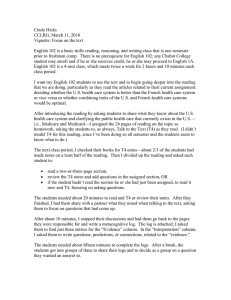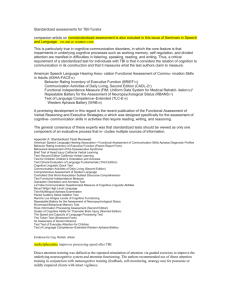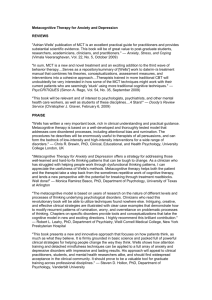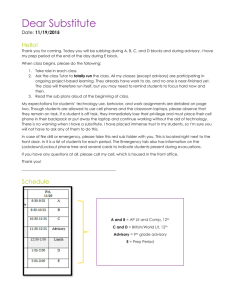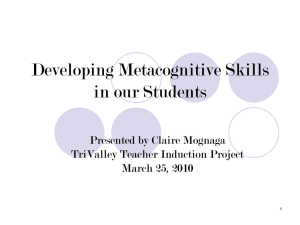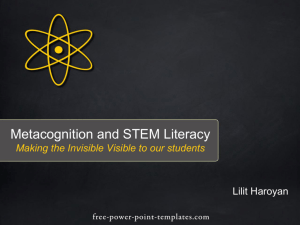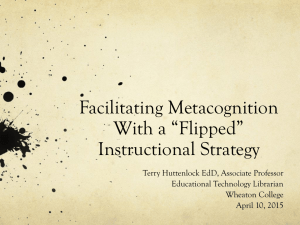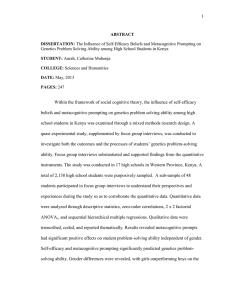Instructional Strategies for Secondary Students with TBI
advertisement
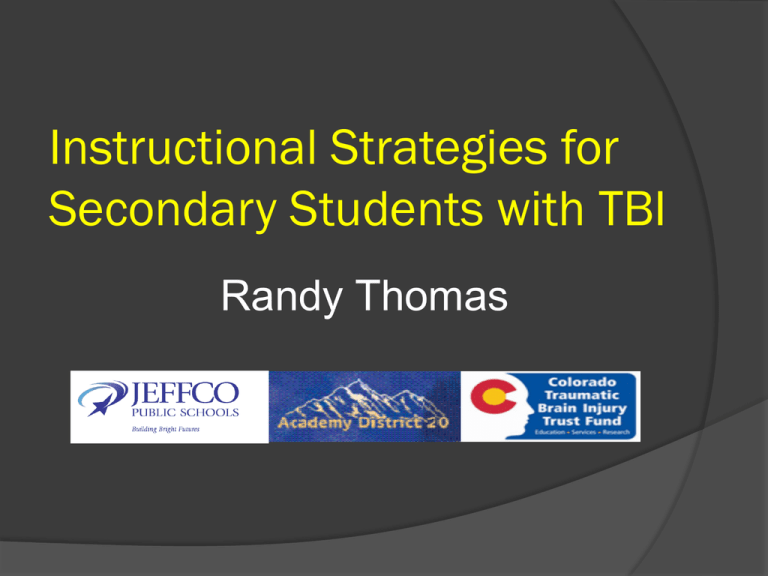
Instructional Strategies for Secondary Students with TBI Randy Thomas Marathon vs. Sprint Building success with a student who has a TBI takes consistent, focused, hard work. It is very difficult for the student. It is very rewarding for the student and the teacher. Successes may require you to look back over a semester or a year to clearly recognize. Coaches don’t expect a kids in casts to run; their injuries prevent them being capable. Overview Everyday Instruction Executive Functioning Memory Attention and Focus Behavior Everyday Instruction Follow principles of good instruction Are often beneficial to entire group Target the Key Concepts Review those key concepts regularly Are highly specific to the individual needs of the student Assess key concepts: pre, formative, & summative 4 Facts on Long-Term changes: No 2 students will be alike. Changes are unlikely to disappear fully over time; the student’s recovery will most likely only be partial. Negative consequences may not be seen immediately but only emerge when developmental demands reveal deficits and problems. An injured brain is less likely to meet the increasingly complex tasks all children face as they get older. Hibbard, M., Gordan, W., Martin, T., Raskin, B., Brown, M. (2001) Students with Traumatic Brain Injury: Identification, Assessment and Classification, Assessment and Classroom Accommodations : NYC, NY Effective Teaching Model 1. Task analysis – break the task down to steps with clear beginning and ending point. 2. Use Direct-instruction to prevent the acquisition of errors in newly developed practices. Examples and non-examples are beneficial. Paint a clear picture of expectations. 3. Frequent assessments: Baseline and regular formative assessments Effective Teaching Model 4. Frequent reviews combining visual and verbal ques. 5. High rates of correct, practice trials: 5 trials is not enough, 30-50 practices with mass practices initially followed by consistent reinforcement practices. 6. Metacognitive strategy training: Selfevaluation of one’s own performance. Executive Functions Those mental capacities necessary for formulating goals, planning how to achieve them, and carrying out the plans effectively. (Leak, 1982) Dysexecutive Syndrome Impulsiveness Poor social judgment Difficulty interpreting other’s behavior Perseveration Poorly regulated attention Disorganized Ineffective planning Decreased flexibility Slowed processes Limited divergent thinking Concrete thinking Limited problem solving Weak selfmonitoring Reduced attention Metacognitive Strategies Self-regulation (“Self-talk” or Social Stories) A repeated phrase or narrative to help guide the student through a specific task – Student Planner: ○ I need to write my home work in my planner. ○ Today is Monday, find the Monday column. ○ This is math class; find the row for math on Monday. ○ Look at the “homework” section on the marker board. ○ Copy the homework neatly on Monday/Math. ○ Have my teacher (or study buddy) check it for me. • http://rsaffran.tripod.com/social.html • Carol Gray Examples of External Aids A student may take 15 minutes trying to start but perceive that it has only been 1 or 2 minutes. Time Management Kitchen or digital timers http://www.online-stopwatch.com/ Day planners Task Specific Checklist (homework, materials, readiness routines) Color coding/labeling Set up all classroom binders exactly the same Homework Helper 1. Pull out homework list (planner…etc.) 2. Make homework list in priority order 3. Start working now! Start my timer. a. Find book, worksheet, & pencil. b. Read directions. c. Ask for help only if you need it. 4. Turn in completed work! Great Job! Keep working hard! Examples of Metacognitive Strategies Self-monitoring of Attention Monitoring progress and/or success during an activity Step-by-step task-specific checklist can be used to support difficult tasks May include error checking and motivation on the checklists Student self rates success during and after task and documents successful strategies The On-task Traffic Light!! Red Light Stop!! Am I doing what I am supposed to be doing? Yellow Light Look! What should I be doing instead? Green Light Go!! Choose a new direction and move forward! Examples of Environmental Modification-Physical Set up Seating – have the same seating in all classrooms if possible…i.e. front right side. Sound management – ear plugs or head set Distraction management – no irrelevant items The more that a student’s environment is standardized across classrooms, the easier it is to focus on instruction in each class. Examples of Environmental Modification-Physical Set up Structure task in step-by-step format. Give one portion of a task at a time. Single step instructions Routinize tasks. Put time estimates at the top of the paper. Assign a peer buddy. Natural Support Modify instruction style to accommodate individual student. Facilitate a supportive social environment. School counselors are a great resource to engage classmates in creating a supportive climate. Work towards common expectations and practices between home and school. Combination Approaches External Aid + Metacognitive Practice Digital timer combined with self-talk Natural Supports + External Aid Classroom/school-wide culture and assignment completion system Environmental Modification + Metacognitive Task accommodation and self-advocating for help ○ Model how to self-advocate & allow practice Memory Short term memory is broken. Try carrying water using a tea strainer to better understand their frustration. You look at the board, say in your head what you need to write down, look down at your paper….what was that again? Provide the aids necessary to compensate. Lecture notes Completed graphic organizers Attention and Focus Students remember the beginning and end of a lesson. Chunking limits the forgotten middle. Break up the lesson with physical activities. Sensory diet Crossing the midline engages both sides of the brain and causes both sides to communicate. Situational Teachers What does each person need today for that specific task? Motivation High Capability Low Motivation Low Capability Low Motivation Needs encouragement Needs instruction and encouragement High capability High motivation Low capability High motivation Needs autonomy Needs instruction Capability Behavior Behavior is communication; am I listening to understand? What is being communicated? I don’t know what I’m supposed to be doing. I don’t know how to do the work. I count using my fingers and can’t remember my multiplication facts, and you want me to do what? I don’t want to look like an idiot; I’d rather just be in trouble. There are Two Plans Plan A Oh, let’s just sporadically provide individualized instructions and make on-thefly adjustments and hope it works. Plan B Observe behavior, think through intervention options, systematically apply the most feasible option, evaluate to determine effectiveness, make purposeful modifications. Summary Everyday Instruction – Effective teaching model Executive Functioning – Select the most needed target. Memory – Provide aids as needed. Attention and Focus – Chunking and physical activity Behavior – What is this kid saying?
